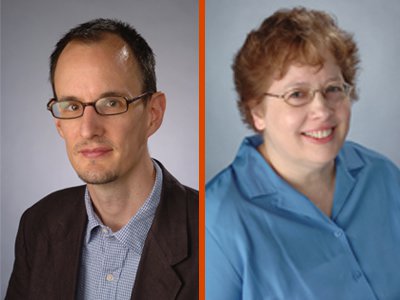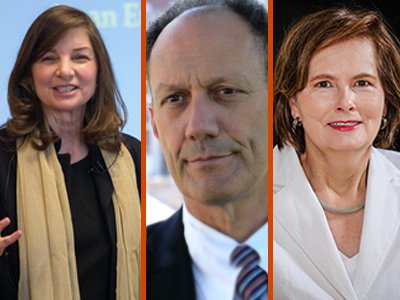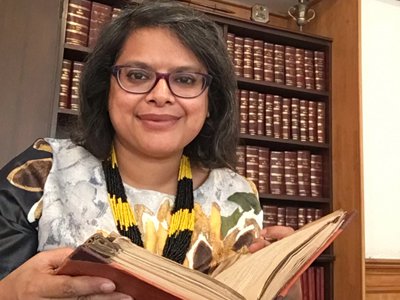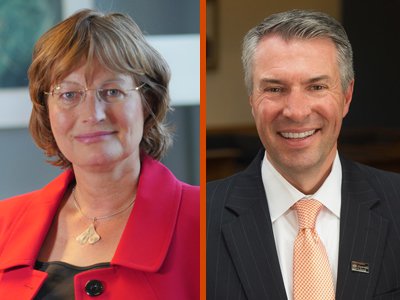Valuing the Humanities
First in four-part series about humanities research at Syracuse

Michael Ebner anticipates a busy summer. When not in his office in Eggers Hall, fulfilling his duties as chair of the Department of History, the Syracuse University professor will spend two months in Rome, conducting archival research for a book on Italian Fascism.
Thanks to a $6,000 Summer Stipend from the National Endowment for the Humanities (NEH), Ebner will study how Italian Fascists ruled colonies in Africa. Such research, he says, will glean insights into other forms of modern-day imperialism. “Most of my previous research has been on political violence, so I will pay close attention to the coercive actions of Italian colonial authorities,” says Ebner, dually appointed to the Maxwell School of Citizenship and Public Affairs and the College of Arts and Sciences.
The manner by which imperialist powers attempt to subjugate peoples—economically, politically and otherwise—is arguably just as reprehensible today as it was in the 1870s, when European states began establishing vast empires in Africa, Asia and the Middle East.
Ebner appreciates the time to do uninterrupted work and the funding that will cover most of his research-related expenses. He also knows that grants such as his are in danger of becoming extinct. In March, President Trump called for the elimination of the NEH, along with the National Endowment for the Arts (NEA), the Corporation for Public Broadcasting (CPB) and other arts and cultural agencies. Congress responded with a bipartisan agreement on a bill to fund the agencies for the rest of the current Fiscal Year (FY) 2017 budget, ending Sept. 30. Trump expects to sign the bill, which would allocate $150 million each for the NEH and NEA, a $2 million dollar increase respectively from last year.
As for the FY2018 appropriations bill for funding the federal government from October 2017 to September 2018, anything can happen. This bill is the one in which Trump recommends eliminating the NEH, NEA, CPB, etc.
Is Ebner worried? “The end of the NEH would remove federal government support for all types of humanities-based scholarship, while retaining support for scientific research,” he says. “Deciding that humanities research is unimportant or irrelevant to the common good in the United States is, in my view, a mistake.”
Scholars agree that, with increasing globalization and contingency, rethinking the humanities is important. At Syracuse, these areas include African American studies; art and music histories; English; languages, literatures and linguistics; philosophy; religion; women’s and gender studies; and writing studies, rhetoric and composition. Ebner says that, while most historians—and humanists, for that matter—are accustomed to working on shoestring budgets, the real losers of NEH support are the American public, many of whom have had their lives enriched by NEH-funded projects, sometimes without realizing it. They include Ken Burns’ “Civil War” documentary, the 1976 King Tut exhibition and the rediscovery of Jamestown.
“If Washington decides that the federal government should play no role in teaching children of all backgrounds, enriching communities and preserving American history and culture—that only science and technology are worthwhile—it will profoundly degrade public life, and the appreciation for, and advancement of, our own culture,” Ebner continues.
There was little doubt before Trump’s 2017 budget was unveiled that it would bolster spending on police and the military, at the expense of the arts, scientific research and environmental protection, writes Laila Lalami in The Nation. “Yet the president still managed to surprise with the scope of his proposed cuts,” she says, adding that the NEH, NEA and CPB account for 0.02 percent of the federal budget—a pittance compared to billions annually spent on arts and culture by nations such as France, Germany and Sweden. “The simple truth is that cutting the NEA and the NEH will do nothing to help balance the budget, although it will severely affect states that depend on these agencies to fund cultural or educational programs. [For example, 40 percent of NEA funding goes directly to states to finance arts programs, particularly in rural areas.] Often, it is through such programs that children from poor or underserved communities get access to arts or music education, which, in turn, boosts school performance.”

The fate of the NEH is of interest to Syracuse faculty because it provides critical support for humanities research, teaching, preservation and programming, such as the Humanities Open Book Program. A joint project between the NEH and The Andrew W. Mellon Foundation, the Open Book Program repurposes out-of-print humanities publications as open-access ebooks. Syracuse is one of eight institutional participants, and Alice Pfeiffer G’77, G’86, director of Syracuse University Press, is using a $58,000 award to digitize 23 titles from its Irish Studies and New York State series.
“We are honored and grateful to the NEH for this chance to bring important books of humanistic interest back into conversation with current scholarship, and to make them openly available to a global community of readers,” says Suzanne E. Guiod, editor in chief of the Press.
Adds Pfeiffer: “Central to our mission is the preservation and dissemination of scholarship. The NEH grant provides the path to make sure these books are preserved in digital formats that will make them accessible for generations to come.”
Like the NEA, the NEH reaches every state and congressional district. Kathy Everly, who chairs the Syracuse University Humanities Council (comprising mostly department chairs and program directors in A&S and Maxwell), applauds Congress’ recent support of the NEH. “The humanities are not partisan,” she says. “They’re not a luxury, and you don’t need to be a Democrat or a Republican to enjoy them. Congress has the ability to fund the NEH, despite Trump’s proposals, and we need to make sure [members of Congress] understand the impact of what the agency does.”
Everly is a professor of Spanish literature and culture. Nowhere is humanities funding more critical, she says, than in scholarly research. In A&S, the humanities are a major category within the liberal arts, which includes the natural sciences/mathematics and the social sciences, offered in conjunction with Maxwell. The result? More than 175 professors working in some two dozen academic departments and programs dedicated to the humanities. That research has many modes: disciplinary, interdisciplinary, individual, collaborative, public, non-public, digital, medical—the list goes on.
“Yes, the new budget agreement is good news, but it does not erase the atmosphere of tension and mistrust that predominates conversations about humanities in the current administration,” Everly says. “It is the first step in redirecting the current conversation about humanities education and funding in this country and at individual institutions of higher learning at large.”
Modest amounts of money are essential to such scholarly activity. Unfortunately, for all its importance, the academic study of the humanities rarely makes front-page news, compared to that of the sciences, whose effect on public policy is often direct and immediate. Gerry Greenberg, senior associate dean in A&S who oversees the Humanities Division, says there are many reasons why this is so—political, social, economic and cultural. He also is convinced that the humanities are not going away anytime soon.
“As long as human beings are around, the humanities will be around,” says Greenberg, the author of a well-turned article in The Washington Post titled “The Tao of the Liberal Arts.” “In fact, their importance is probably greatest when their popularity is ebbing. The liberal arts and a liberal education are the way to go, and, while all the fields in the liberal arts are part of the way, the humanities are the heart of the way.”
Greenberg explains that applications for humanities research and humanities-related activities are not always as clear-cut as STEM (science, technology, engineering and mathematics). Thus, it can be difficult to quantify humanities funding and outcomes, with the many federal, state and local agencies involved. “It’s harder to assess what we do,” he says, “which is why the humanities often have difficulty in the search for money.”
Humanities scholarship thrives on competitive grant awards. At Syracuse, federal and state agencies—such as the NEH and Humanities New York (née the New York Council for the Humanities), respectively—do much of the heavy lifting. This translates into opportunities on and off campus. Rachel May, director of sustainability education for the University, is helping create a prototype of a digital atlas of nearby Onondaga Lake, a sacred space for the Haudenosaunee Confederacy for more than a thousand years. The project is supported by a $29,000 grant from the NEH, and includes Jane Read, associate professor of geography in Maxwell, and Phil Arnold, associate professor and chair of religion in A&S.
“Drawing on various methods and techniques, including the digital humanities, we’re creating a comprehensive survey of the historical, cultural and economic significance of Onondaga Lake that ultimately becomes a tool for respectful communication,” Arnold says.
He and May also are spearheading a $91,000 grant project from the U.S. Environmental Protection Agency involving students and faculty from Syracuse and the SUNY College of Environmental Science and Forestry, as well as Haudenosaunee consultants. They are using the Haudenosaunee Thanksgiving Address to help teachers and students understand the cultural and ecological significance of the lake.
Other types of public support include NEA Creative Writing Fellowships and various NEH fellowships, Public Scholar and Faculty awards, and Summer Stipends. Common to all of them is the pursuit of original research and scholarship. At Syracuse, this has resulted in an abundance of articles, monographs, books, digital materials, archaeological site reports, translations, editions and other scholarly resources. The funding also has spawned a few careers.
In 2005, Stephanie Shirilan received a fellowship to attend an NEH Summer Research Institute at the John Carter Brown Library in Providence, Rhode Island. The opportunity eventually led to a faculty appointment in A&S. “The experience helped me envision a career in the humanities in practical terms,” says Shirilan, an associate professor of English, who works at the nexus of cultural critique and canonicity. “It helped me become familiar and competent with materials I would use in teaching and helped me articulate questions I would pursue for the next 12 years.”
Likewise, Mary Karr and Bruce Smith, professors in the top-ranked M.F.A. Program in Creative Writing, have benefited immeasurably from NEA support. Both were struggling writers in 1984, when they received grants for $12,000. “It was life-changing,” recalls Karr, who went on to publish her first volume of poetry. Adds Smith: “I was teaching high school, and had a four-year-old kid. The money allowed me to take time off to complete my first book of poems.”
Recent examples include Amy Kallander, an associate professor of history who also is affiliated with women’s and gender studies (WGS) in A&S. She used an NEH Summer Stipend to study rare Tunisian periodicals at the National Library of France. Moreover, four professors in Maxwell’s Department of Anthropology—Doug Armstrong, John Burdick, Maureen Schwarz and Sue Wadley—have received continuous NEH support for more than 25 years, driving global learning and collaboration in unique ways.
Although the NEH provides critical support for many activities at Syracuse, the agency is at its lowest funding level since 1971. Thus, humanists are increasingly turning to private sources for help. They range from individuals, corporations, foundations, nonprofit arts and culture organizations to the University itself.
Probably no other private entity has done more for humanities research at Syracuse than the Mellon Foundation. Since 2006, Mellon has awarded more than $5 million to the Central New York Humanities Corridor, a large-scale, interdisciplinary research project comprising nine institutions, including Syracuse, Cornell University and the University of Rochester. Mellon’s support may help the Humanities Corridor remain a program of the Syracuse University Humanities Center in perpetuity, as it has formed the basis for a matching endowment program. Syracuse, Cornell and Rochester—the corridor’s founding partners—have until December 2017 to meet their campaign goals, bringing the cumulative endowment to $6.5 million.

Gregg Lambert, the Humanities Corridor’s director and principal investigator, recalls how the Humanities Corridor and the Humanities Center (of which he was founding director from 2008 to 2014) have flourished in the face of adversity. “The fiscal crash, a decade ago, forced us to do things differently,” says Lambert, also a Dean’s Professor of the Humanities. “The Humanities Corridor helped bring a number of organizations that had been on the periphery of the University into the fold. It also supported collaborations in the humanities throughout the region, amongst institutions. We pooled our resources. I don’t know if what we did was the result of genius or accident, but, thanks to Mellon’s support, it worked.”
Today, the Humanities Corridor is a national model of excellence. It has sponsored more than 100 different working groups, coordinated by nearly 300 regional scholars. The groups, in turn, have generated more than 400 scholarly activities, including panel discussions, lectures, screenings, readings, performances, workshops and master classes.
“The humanities and the liberal arts are central to the Syracuse University educational experience and are an important part of our emerging Academic Strategic Plan,” says Syracuse Vice Chancellor and Provost Michele Wheatly. “The Humanities Corridor has created ‘corridors of intellect’—attracting stellar faculty and new, inspired talent to Central New York, while drawing on the distinct histories and assets of the region.”
Likewise, the Humanities Center is a hub of vibrant scholarship and dynamic programming. Located in the beautifully renovated Tolley Humanities Building, the center resides in A&S but has served the entire campus community for more than a decade. In addition to faculty and graduate student fellowships, as well as visiting professorships, the Humanities Center supports events and activities, such as the yearlong Syracuse Symposium, a public humanities series focusing on an annual theme.
“Much of what we do aligns with the University’s commitment to high-impact research,” says Vivian May, the center’s director since 2015 and a professor of WGS. “We support interdisciplinary collaboration and foster public engagement in the humanities. The Humanities Center adds to the strengths of our individual departments and programs by providing a common space for scholarly exchange. By nature of our location, we are a physical and symbolic gateway to campus.”

The Humanities Corridor, the Humanities Center and the renovation and rededication of the Tolley Building all arose during the deanship of Cathryn Newton, dean emerita of A&S, professor of interdisciplinary and Earth sciences and now also Special Advisor to the Chancellor and Provost for Faculty Engagement. She expresses great appreciation for the rapid evolution of both the Humanities Corridor and the Humanities Center.
“The Syracuse Humanities span an exceptional range of fields—both the disciplines and many interdisciplinary areas—with a truly lustrous history of research and creative work. Yet other universities throughout the world compete fiercely to attract the best Humanities scholars and students. We must invest continually in our SU Humanities programs to deepen and extend their impact,” Newton says. “At every gathering of A&S alumni I have attended, someone rises to express, often eloquently, the influence of a particular humanities course or curriculum on a life at Syracuse.”
Romita Ray often jokes that her work is “steeped” in the humanities—she is, after all, an authority on the visual histories of Indian tea. During a meeting in Bowne Hall, the Calcutta-born historian riffed on the merits of humanities research at Syracuse. Interestingly, the conversation was as much about STEM as arts and culture.
“Even a scientist is a humanist, right?” she asks rhetorically, between sips of Ceylon Black. “Since ancient times, science and the humanities have coexisted naturally. Only in the past century have they become polarized. I think the academy is realizing that scientists and humanists, despite their stereotypical differences, are natural partners. They’re inquisitive and open-minded; they just approach their subjects differently.”
Ray, whose great-grandfather founded the first Indian tea planters association in British India, has spent much of her academic career working at the margins. In addition to serving as chair of the Department of Art and Music Histories (considered the birthplace of the U.S. interdisciplinary humanities movement), she is an associate professor of art history. On paper, Ray’s interests seem attuned to mostly art and architecture of the British Empire in India. A quick glance at her overstuffed bookcase, however, reveals a coat of many colors. The history of science, landscape studies and post-colonial theory are some of her other areas of expertise.
“Our faculty are known for their world-class research and for creating opportunities for intellectual exchange,” says Ray, who recently availed of a yearlong fellowship—her third NEH grant award—to conduct research for an upcoming book in three different countries. “This excellence manifests in the classroom and branches out to other parts of campus and the community through lectures, workshops and symposia. We do not confine the humanities to a single school or college. They’re in every building on campus.”
Ray ticks off the names of various centers and institutes at Syracuse that engage in “humanistically oriented research.” At the top are the Humanities Center and Humanities Corridor, followed by a dozen other units, ranging from the Moynihan Institute of Global Affairs and the South Asia Center to the Institute for National Security and Counterterrorism. She singles out the Special Collections Research Center and the Belfer Audio Archive (both of which are in Syracuse University Libraries) and SUArt Galleries as powerfully valuable resources.
When pressed for a pithy explanation of the humanities, Ray responds with the “study of human experience”—specifically, the quest for knowledge, values, purpose and meaning. How humanities research folds into teaching is of particular interest to her because the approach varies among departments, programs and professors.

“Faculty research can be fun for undergraduates because they get to see a different side of you,” Ray says. “By telling your story, you become more human, more accessible, to them. This creates a more rewarding classroom experience for everyone involved.”
Everly agrees with Ray, suggesting that faculty and students should approach research differently. “As scholars, we do field work, such as visiting archives, archeological sites and other communities and cultures, to articulate our findings,” she says. “In turn, getting students out of their seats, literally and metaphorically, to see the world as a global community is important. It helps them reconsider what they think they know.”
Everly references Cherríe Moraga—a leader in Chicana, feminist, queer and indigenous activism, art and scholarship—who was this year’s Jeannette K. Watson Distinguished Visiting Professor in the Humanities. For two weeks in February, the Stanford professor headlined a series of lectures, performances and dialogues organized by the Humanities Center. “Most of the events started with students reading a text,” Everly says. “Cherríe then helped our students explore these ideas in the context of historical problems, community awareness and political solidarity. It was a terrific blend of teaching and research.”
Discourse is one of the most important aspects of humanities research. Ray recalls how a news story about her tea research caught the eye of a professor in the Falk College. Before long, she was invited to speak about her project to food studies majors. “The humanities are the intellectual corridor that connects different fields. They are the basis of who we are,” Ray says.
Such conversations can happen spontaneously. Roger Hallas, associate professor of English, noticed this in March, when he spoke about his forthcoming book on photography and documentary film at a Society for Cinema and Media Studies (SCMS) conference in Chicago. While he was there, Hallas pitched his next project, an edited collection on visual arts documentaries, to a number of editors from academic presses, all of whom expressed interest. “My idea for the collection came from putting together a panel on visual arts documentaries at SCMS the previous year,” says Hallas, a Spring 2017 Humanities Center Faculty Fellow. “I saw, from the conversation, that there was not only a gap in the scholarship but also an interest in the field for it to be filled.”
Hallas considers the edited collection a companion piece to his current book project, “A Medium Seen Otherwise: Photography and Documentary Film,” to which he already has received commitments from many contributors. “We humanities scholars predominately pursue the almost monastic labor of individual research,” he says, “so I am always eager to seize opportunities for collaborations across the humanities.”
Adds Ray: “We should never underestimate the power of conversation. It’s where great ideas are born.”
Any discussion about humanities research—its value, how it is expressed, how its effectiveness is measured—usually involves the so-called “image problem.” Heidi Tworek, a fellow at the Transatlantic Academy and an assistant professor of international history at the University of British Columbia, has written extensively on the subject. (Her 2013 article in The Atlantic, titled “The Real Reason the Humanities Are ‘in Crisis,’” is required reading for almost anyone in the liberal arts.) Tworek argues that a number of factors—including gender, race, ethnicity and class—have shaped public perception of the humanities. She also believes that Trump may not be entirely bad for business. “It’s too soon to tell, but, at least on first inspection, [his] presidency may have revived student interest in the humanities and renewed faculty commitment to teaching critical thinking skills,” she says. Tworek illustrates her point by saying that history is the largest major at Yale for the Class of 2019 and that the University of Washington offers a course on “Calling Bulls—t,” replete with online videos.
Stanley Fish also has written about the humanities’ “PR problem.” A renowned literary theorist and legal scholar, he is known for his 2008 op-ed in The New York Times, in which he infamously wrote: “To the question ‘of what use are the humanities?,’ the only honest answer is none whatsoever.” Nearly a decade later, many humanists still chafe at the idea.
“Humanities teachers and scholars became incredibly defensive, but there also were people who felt they could use his comments to justify the defunding or financializing of the humanities,” says Lambert, regarding Fish’s article. “These kinds of overreactions can be damaging because they set into motion events that can take years to undo.”
During a recent phone conversation, Fish explains how some of his comments may have been misinterpreted. It is not that he is opposed to the humanities; he simply wants people to distinguish between the humanities as a public practice and presence (e.g., plays, poetry readings, Shakespeare festivals, concerts and lectures) and the academic study of the humanities.
“The first is easily defensible because everyone wants his or her town to have a performing arts center and a couple of good bookstores,” says Fish, the Davidson-Kahn Distinguished University Professor of Humanities and Law at Florida International University, as well as the Floersheimer Distinguished Visiting Professor of Law at Yeshiva University. “The second is a specialized academic enterprise in which poems are explicated, authoritative editions are produced, and received accounts of historical events are challenged. This enterprise is hard to defend because the benefits—for example, having an up-to-date edition of a minor 15th-century poet—are not clear to the layperson. The reason they are not clear is that, in practical terms, in terms of the state’s bottom line, there aren’t any.”
Fish points out that the academic study of the humanities offers so-called “pleasures”; however, marketing or linking them to society’s central concerns can be difficult. “[The academic study] becomes an acquired, somewhat esoteric taste,” he continues. “The only way to enlarge the base of people willing to acquire and subsequently pay for it is to get more and more people into our classes, perhaps by means of the technological devices now available to us.
“Anyone can appreciate the value of having cultural resources in the community, but the value of subjecting those resources to rigorous and extended critical analysis, which is what academic humanists do, can be appreciated only from the inside.”
May considers the humanities’ ostensible “image problem” a misnomer. Over coffee in the Tolley Humanities Building, she explains how humanistic research has repeatedly altered the course of history, noting the extraordinary work it has performed in advancing research, scholarship and culture. The humanities also have been pivotal to solving concrete problems in fields as diverse as law, medicine, economics and science. “We all know how important the humanities are, with their emphasis on critical thinking, cultural awareness, creativity, compassion and innovation,” she says. “So why are they considered a luxury?”
Dympna Callaghan, the William Safire Professor of Modern Letters, may have part of the answer. A colleague of May’s, Callaghan is a scholar of Renaissance poetry and drama who also follows key issues in global higher education. Callaghan insists the humanities “prepare people for lives as free men and women”—to quote Kwame Anthony Appiah, professor of philosophy and law at New York University and past president of the Modern Languages Association. “I don’t think it gets any clearer than that,” she adds.
Callaghan believes “training” and “education” are two different things and that the humanities are integral to only the latter. “We don’t want to train people to be cogs in a well-oiled machine already set up by employers,” she says. “That is not education; that is merely training. Education is dangerously disruptive to training and to the pedagogical assumptions that lie behind it.”
The British-born scholar says training prepares students for a rather narrow sweep of jobs that already exist, whereas education opens up their intellectual and cultural horizons to an almost infinite range of employment. Callaghan salutes Syracuse’s commitment to creativity and innovation, which, in turn, produces articulate, authentic and ethically responsible students. “Training can be a component of education, but, in and of itself, is devoid of the questions posed by humanist inquiry,” she says. “Education prepares students for life—for responsible citizenship, for community building or for whatever shape employment takes in the future.”
David M. Van Slyke, professor of public administration and international affairs and dean of the Maxwell School, has this to say: “The humanities challenge us to recognize and appreciate diversity, and to foster an understanding of different viewpoints. This focused effort to create a culture of dialogue and engagement and to overcome barriers is the very essence of effective citizenship.”

Perhaps the “image problem”—if one truly exists—stems from a general misunderstanding about the field itself. In his landmark book, “A New History of the Humanities” (Oxford University Press, 2013), Dutch scholar Rens Bod examines the “feats and deeds of humanistic inquiry” from antiquity to the present. Such overviews are commonplace in the sciences, but not so much in the humanities. “As if humanists have no clue about their own history, insights and applications [that were the result of humanistic research] have been credited to the sciences,” he writes.
Regardless, declining humanities enrollment gives faculty pause. The reasons are many—the corporatization of higher education, an increase in online undergraduate courses and adjunct faculty, the weakening of liberal arts distribution requirements.
The liberal arts landscape has changed drastically since the 1970s, when humanities enrollment started to drop. Faculty and administrators have since been rethinking research assessment and evaluation in not only the humanities, but also the natural and social sciences.
When asked about measuring the efficacy of humanities research, Tworek turns the question around, inquiring if the academy has done any better with STEM. “Science literacy is still sorely lacking in the general public,” she says. “Part of the problem with any measurement system is that the benefits of research may be unclear at the time or for decades afterward.” The “usefulness of useless knowledge,” coined by U.S. educator Abraham Flexner in 1939, has triggered some of history’s biggest innovations. Case in point: The United States did not award the first radio system patent until 30 years after the discovery of radio waves.
On a purely academic level, Tworek thinks measuring humanities research starts by acknowledging the field’s parameters. The notion of academic authorship, for instance, is a sticking point among humanists, whose single-author books and papers seemingly lack collaboration compared to scientific articles, whose bylines can take up pages. Assessments of merit, Tworek says, also should take into account digital output (e.g., webcasts and podcasts) and non-quantitative methods.
Several professors think coordinated communication may help raise the humanities profile at Syracuse. Some kind of institutional clearinghouse or searchable database for humanities proposals, grant awards, teaching opportunities and news stories is one idea bandied about by faculty. (Granted, most of this information resides in the Office of the A&S Dean and the University’s Office of Sponsored Programs, but some say they would like to see a more comprehensive, coordinated effort.) “If we want to cultivate a donor, attract a particular student or faculty member or mentor each other as colleagues, we need to have something at our fingertips that helps us tell our story in a consistent way,” May says. “I’m not saying that the information isn’t out there; it is. I’m saying that we, as professors and administrators, should look at how we can better access and utilize it.”
Ray goes a step further. Anyone who has been to a Humanities Council meeting likely has heard her museum rap—creating a stand-alone building that would advance the University’s teaching and research mission through exhibitions, screenings, performances and academic programming. “Let’s say you have an exhibit on theater design. It could bring together people from Arts and Sciences, VPA [the College of Visual and Performing Arts], the School of Architecture, Newhouse,” she says, adding that museums are de rigueur for Ivy League institutions. “What a humanities conversation that would be.”
Karin Ruhlandt, dean of A&S and Distinguished Professor of Chemistry, understands the importance of cross-disciplinary work. For example, she meets twice a month with Van Slyke to identify opportunities for student and faculty collaboration. “We want to break down academic silos and cultivate horizontal thinking,” she says. “We also know there’s a growing demand for liberal arts majors. It’s easier to hire people who already know how to think critically than [for employers] to train them to think critically.”
What of the NEH’s possible elimination? “I’m disappointed, more than anything,” Ruhlandt shrugs, “because we must give full value and support to all branches of scholarly and cultural activity, not just the STEM fields. The funding extension is promising, but our work is far from done. In some ways, it’s just beginning.”
